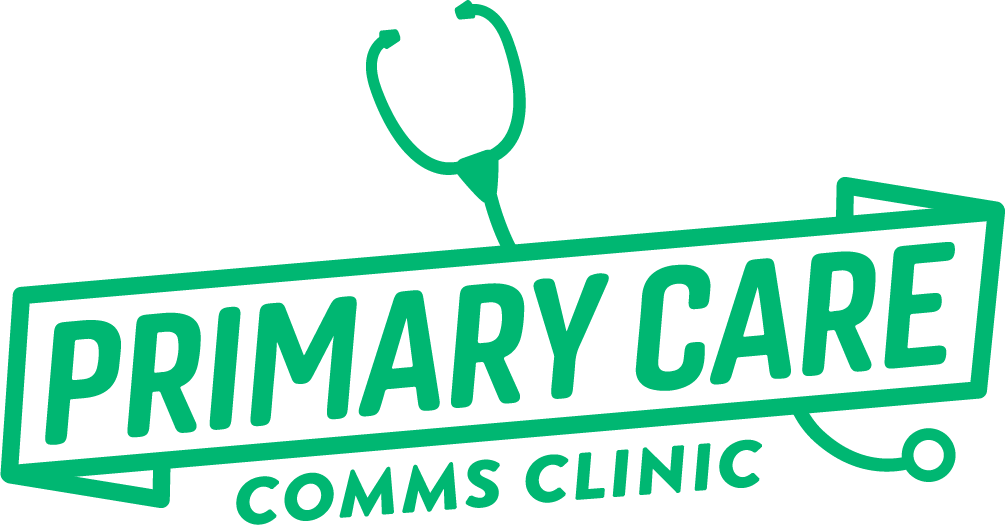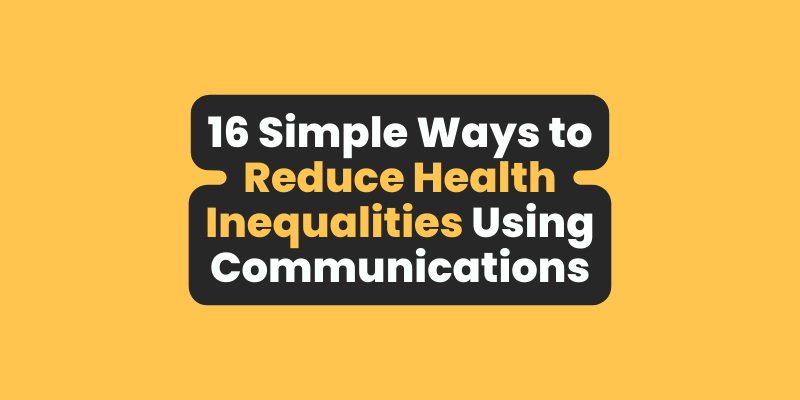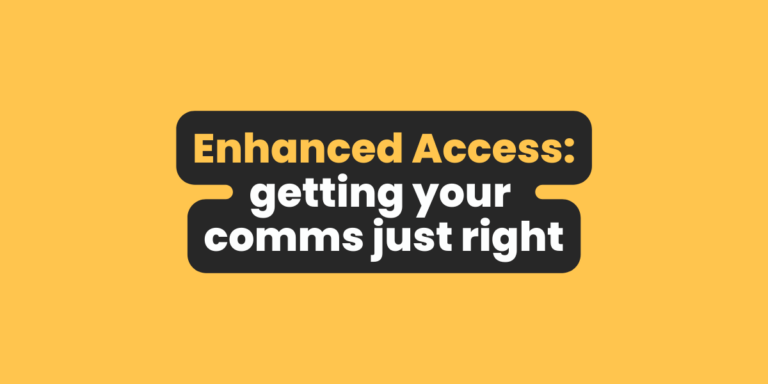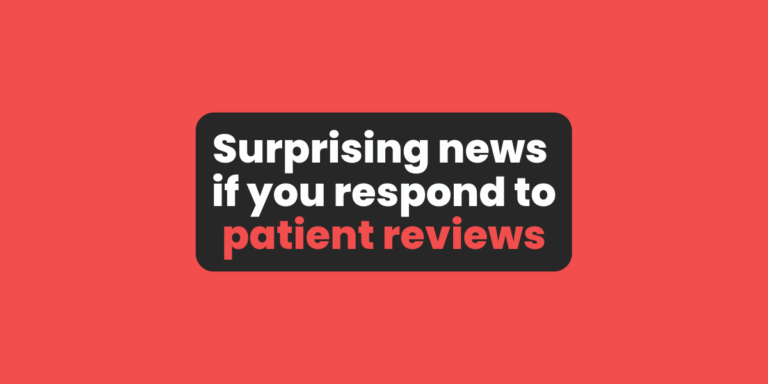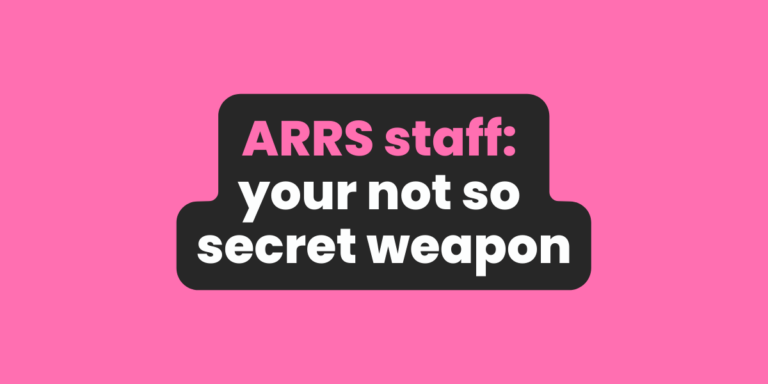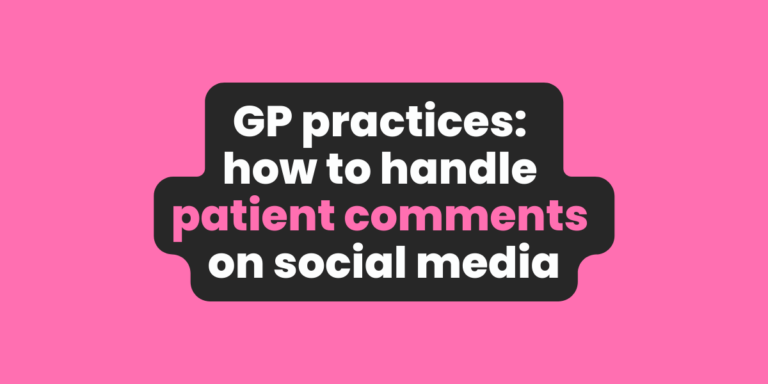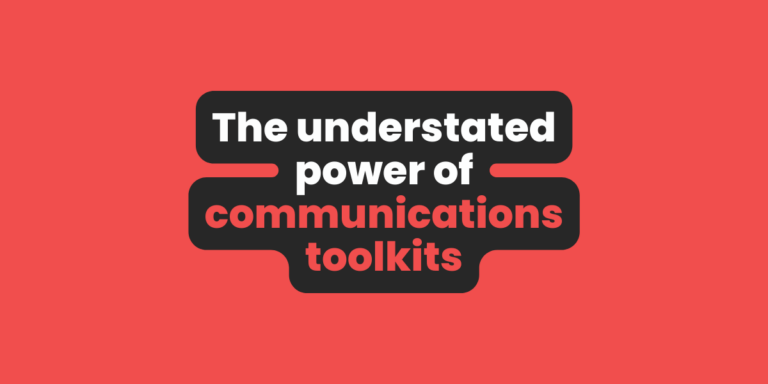Good primary care should be for everyone, no matter where they live. If you’re an NHS GP practice or primary care network, you’ll already be doing what you can to reduce health inequalities locally.
But did you know there are some very simple actions you can take with your patient communications and engagement to make a difference too?
We share 16 simple ways to reduce health inequalities using communications in your GP practice, based on just some of the work we’ve done in our communications consultancy work, in this infographic.
Here’s a quick summary:
- Use simple words
- Text message reminders
- Explain medical terms
- Use pictures and diagrams
- Share stories
- Offer translations
- Have accessible formats
- Give written instructions
- Have clear signage
- Use hyper-local media
- Community outreach
- Feedback boxes
- Accessible NHS websites
- Health workshops
- Friendly patient reminders
- Patient support groups
Check out the infographic for more detail.
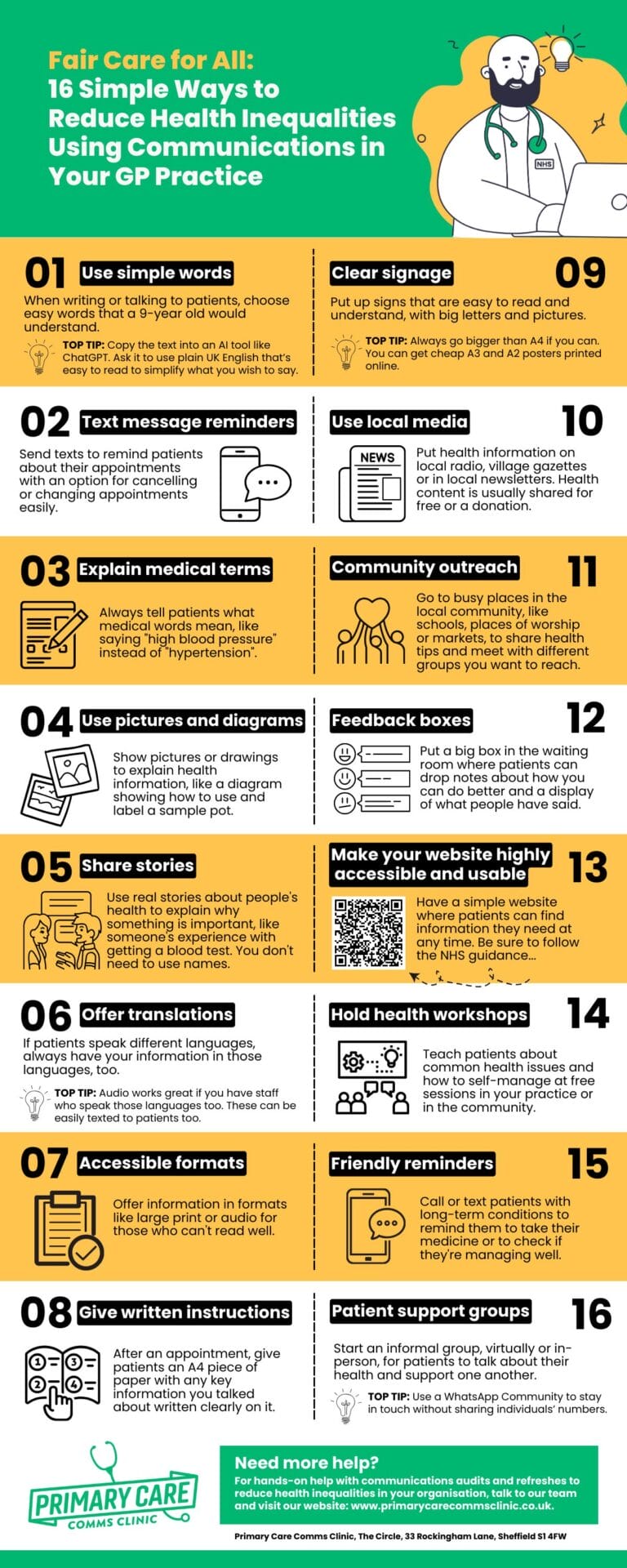
Good communication and engagement play a vital role in reducing health inequalities in communities. When we talk and write clearly, listen and respond well, we understand each other better. This means that everyone, especially people living in areas that don’t have as much, can get the healthcare they need.
Simple changes can make big differences. Working with our partners at DKJ, we proudly deliver training and projects to support primary care organisations in this area. Some of these might seem obvious but these are just some of the practical things you can do very quickly to make a real difference for your patients, reduce health inequalities and ensure “fairer care for all”:
- Use simple words: Anytime you’re interacting with patients, use everyday language over complicated medical jargon. The goal is to convey information that even a 9-year old can comprehend. To achieve this, online tools like the Hemingway App or an AI tool like ChatGPT can be indispensable. Simply provide the complex text and prompt AI to generate a simplified, easy-read version.
- Text message reminders: Use the technology you already have and use in your GP practice to send convenient text reminders about upcoming appointments. Include quick clickable options so your patients can easily cancel or reschedule if necessary.
- Explain medical terms: Break down complicated medical terms in simple language. For example, use “high blood pressure” instead of “hypertension”. Avoid assuming your patient’s vocabulary whilst still respecting their intelligence.
- Use pictures and diagrams: Lots of people understand information quicker and better when it’s in pictorial form. Don’t be afraid to add visual aids to your communications. It’s called “speeding up” not “dumbing down”. Illustrations, diagrams, and photos effectively explain complex health processes or procedures in an easy-to-understand format. For example, how to do a urine sample and package it back up properly to hand over at reception.
- Share stories: Narrating real-life stories in newsletters or on social media through short-form video can build a powerful connection with your patients, especially when people hear that people like them have been supported well. Share instances where a blood test or procedure was helpful and how this helped the patient’s health. You can keep patient information anonymous.
- Offer translations: Have vulnerable patients who don’t read or speak English very well? Ensure inclusivity by offering translation services in your patients’ native languages. For important messages you need to get out quickly, it doesn’t have to be a costly affair either. You can complement written information with audio recordings captured simply on your smartphone to improve comprehension and accessibility. This information can then be easily added to your website or sent out in a text message to the patient.
- Accessible formats: Cater to all patients by providing information in different formats, such as large print or easy-read, to assist those who may experience difficulty reading.
- Give written instructions: A tangible takeaway after each consultation could be an A4 piece of paper with key points from the appointment. Encourage patients to refer to it later to help information retention.
- Clear signage: Use easy-to-read signage around your practice. Utilise large posters wherever you can with clear letters and symbols to guide patients. You can easily get A3 to A0 size posters printed cheaply online from websites such as DoxDirect.
- Use local media: Local media outlets, especially in smaller towns and rural locations, can be better platforms for sharing health information to vulnerable groups. Consider local radio stations, residents or parish newsletters, and local newspapers and magazines that reach a wide variety of residents in your area.
- Community outreach: Extend your reach into the community by visiting local schools, places of worship, libraries, shopping centres, children’s hubs, food banks, council buildings and markets to share health tips and provide quick medical advice where people who could really benefit from your support are already meeting.
- Feedback boxes: Encourage your patients to voice their opinions on areas of improvement. A simple, accessible feedback box in the waiting room can facilitate this. Be sure to have a display board or information near by of what you do with the feedback so patients know you listen and value their input.
- Accessible websites: As a GP practice or primary care network, you should already have or be working towards a user-friendly website that complies with the latest NHS guidance. It should contain easily digestible health information your patients can access at any time of day.
- Health workshops: Consider conducting free health education sessions to increase health awareness in your community. These can be on common health concerns or preventative care measures. If you don’t have space to do them within your GP practice, consider a local community venue or cafe. These places can often be less intimidating too.
- Friendly reminders: Regularly remind patients, particularly those with long-term conditions, to take their medication and don’t be afraid to give them a quick call or text to check up on their health. Care coordinators are brilliant at this sort of work and this approach is working well in a number of areas we support.
- Patient support groups: Offer safe spaces for patients to discuss their health concerns and share experiences. If you can’t meet at a physical location, a WhatsApp Community group can be an excellent tool, keeping individual numbers private but fostering community and conversation.
Navigating healthcare can be challenging for all of us; reducing this challenge via simple, effective communication can significantly narrow the health inequality gap.
If you’re looking for advice or practical support to implement these strategies with a communications focus in your GP practice or primary care network, Primary Care Comms Clinic can help.
Because everyone deserves to be heard, understood and served equally when it comes to our health.
